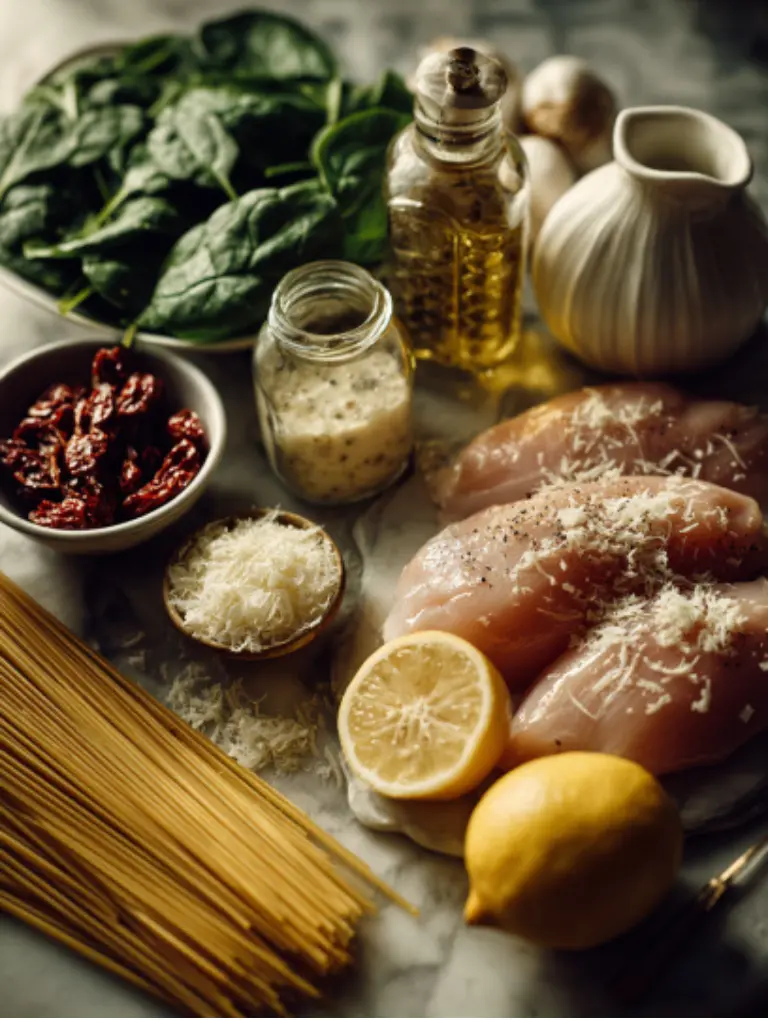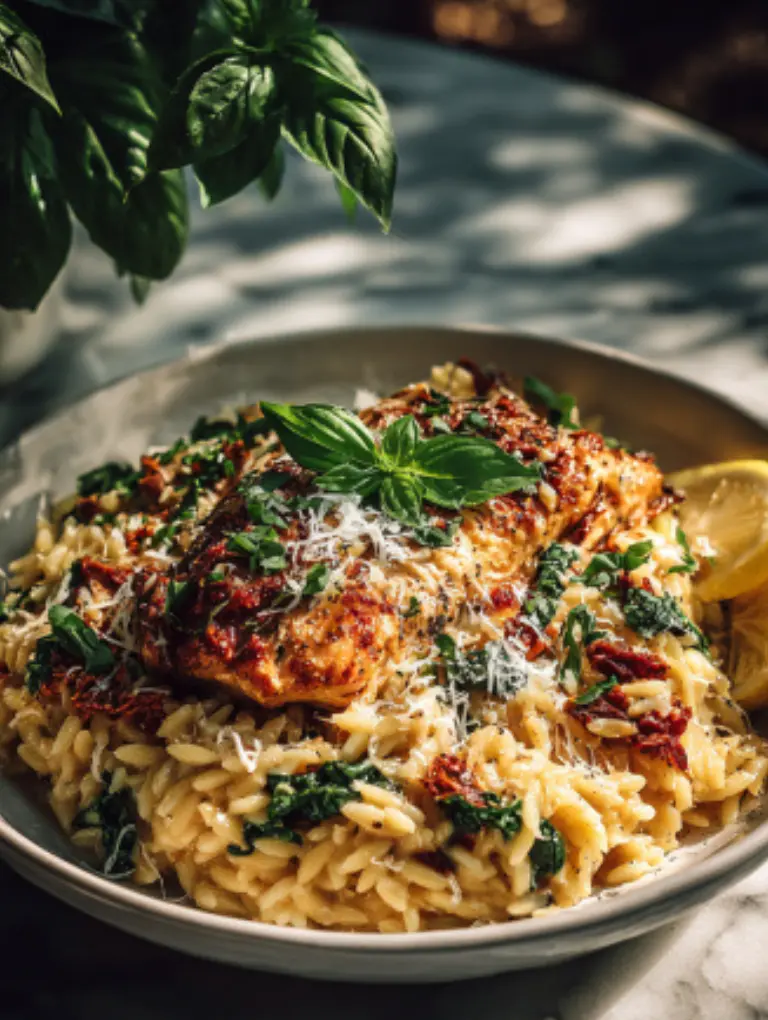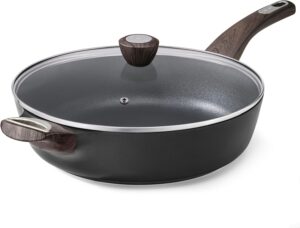Creamy sun-dried tomato chicken orzo is the kind of dinner that makes you feel like you cooked something special without spending hours in the kitchen. Tender chicken simmers with orzo in a rich, silky sauce flavored by tangy sun-dried tomatoes, parmesan, and a splash of cream. Everything comes together in one skillet, which means less cleanup and more time to actually enjoy your meal. It is hearty, flavorful, and ready in about 30 minutes, making it perfect for weeknights when you want comfort without the fuss.
Table of Contents
Skill Level and Quick Tips
This dish is beginner-friendly, with simple steps like searing chicken, simmering orzo, and stirring in cream. Use oil from the sun-dried tomato jar to toast the orzo for extra flavor. Keep a little extra broth on hand in case the orzo absorbs too quickly, and grate your own parmesan for the smoothest sauce.
Ingredients for Creamy Sun-Dried Tomato Chicken Orzo

Primary Ingredients
- Chicken: Boneless, skinless breasts work well for quick cooking, but thighs give a juicier bite.
- Orzo: Small rice-shaped pasta that cooks quickly and releases starch to create a creamy sauce.
- Sun-Dried Tomatoes: Use oil-packed tomatoes for maximum flavor and richness.
- Aromatics: Garlic and onion form the savory base.
- Broth: Chicken stock adds depth, so choose low-sodium to control saltiness.
- Cream & Cheese: Half-and-half or heavy cream combined with parmesan for a silky finish.
- Spinach: Fresh baby spinach stirred in at the end for color and balance.
Ingredient Notes and Brand Cues
- Jarred sun-dried tomatoes in olive oil work best; save some of the oil for toasting orzo.
- Freshly grated parmesan melts more smoothly than pre-shredded.
- Use unsalted or low-sodium broth to keep flavors balanced.
Best Chicken Cut
Chicken breasts cook faster and slice neatly, while thighs bring more tenderness and flavor. Adjust simmering time slightly based on your choice.
Step by Step For Creamy Sun-Dried Tomato Chicken Orzo
Sear the Chicken for Flavor
Season the chicken with salt and sear it in olive oil until golden on both sides. This step locks in juices and creates a base layer of flavor for the orzo.
Toast the Orzo in Tomato Oil
After removing the chicken, add the orzo directly to the pan. Toasting it in the leftover oil and tomato bits adds nutty depth and prevents it from becoming mushy.
Build the Base with Aromatics and Broth
Stir in garlic and onion until fragrant, then deglaze with white wine if using. Add chicken stock and chopped sun-dried tomatoes, stirring well.
Simmer to Al Dente, Stir for Creaminess
Nestle the chicken back into the pan. Simmer uncovered until the orzo is just tender, stirring occasionally so the starch releases evenly. Add a splash of broth if it absorbs too quickly.
Add Cream and Parmesan Off Heat
Once the orzo is cooked, remove the skillet from heat. Stir in half-and-half and freshly grated parmesan until smooth and creamy.
Fold in Spinach, Finish with Lemon and Herbs
Add fresh spinach and let it wilt in the residual heat. Squeeze a little lemon juice or sprinkle fresh basil for brightness before serving.
Doneness Cues and Texture Checks
The chicken should reach 165°F, as FoodSafety.gov advises, the orzo should be tender but not mushy, and the sauce should coat each grain without being watery or clumpy.
Creaminess 101
How Orzo Starch Creates a Silky Sauce
Orzo releases starch as it cooks; heated starch granules swell and burst, thickening the liquid into a velvety sauce, as the University of Kentucky Extension explains.
When to Add Dairy to Avoid Splitting
Add cream and cheese off heat and avoid boiling after adding dairy to prevent curdling, a method Kansas State University Extension recommends; tempering cold dairy also helps.
Fix Too Thin or Too Thick Sauce
If the sauce feels thin, simmer gently for a minute or two longer, stirring until it clings to the spoon. If it’s too thick, splash in extra broth or a spoonful of cream to loosen it back up.
Substitutions and Swaps
Chicken Thighs vs Breasts
Thighs stay juicy even with longer cooking, while breasts cook faster and slice neatly. Either works—just adjust the simmer time to avoid dryness.
Dairy Options: Half-and-Half or Light Cream
Heavy cream creates the richest sauce, but half-and-half lightens it while still keeping things silky. Whole milk can work in a pinch, though the sauce will be thinner.
Gluten-Free Orzo and Timing Tweaks
Gluten-free orzo often absorbs liquid differently. Keep extra broth nearby and stir more often to prevent sticking. Check doneness a minute or two earlier than the package suggests.
No Wine Version
If you’d rather skip wine, deglaze with extra stock and a squeeze of lemon juice for brightness.
Tomato Options if You Lack Sun-Dried
No sun-dried tomatoes? Use roasted cherry tomatoes or even a spoonful of tomato paste. The flavor will be fresher and less tangy, but still delicious.
Variations
Tuscan Style with Spinach and Basil
Add extra spinach, fresh basil, and a pinch of nutmeg to lean into classic Tuscan flavors.
Marry Me Style with Chili Flakes
For a spicier twist, sprinkle in red chili flakes while simmering. This mirrors the famous “marry me chicken” flavor that’s rich, tangy, and just a little fiery.
Extra Veg: Zucchini or Mushrooms
Sauté sliced zucchini or mushrooms after searing the chicken, then simmer them with the orzo for added depth and bulk.
Protein Twists: Shrimp or Sausage
Swap chicken for shrimp, which cooks quickly in just a few minutes, or use Italian sausage for a bolder, heartier profile.
Make Ahead, Storage, Reheating
Fridge Timelines
Store leftovers in an airtight container in the fridge for 3 to 4 days, per FoodSafety.gov; the sauce may thicken slightly as it chills.
Reheat on Stove or Microwave Without Curdling
Warm gently and reheat leftovers to 165°F for safety, as FoodSafety.gov recommends; add a splash of broth or cream and stir between microwave intervals to keep the sauce smooth.
Freezer Notes and Texture Trade-Offs
Freezing is possible, but lighter creams and cultured dairy often separate after thawing, so expect texture changes, notes NDSU Extension; reheat slowly with a splash of broth to bring it back.
What to Serve With It

Simple Salads and Greens
Pair the creamy orzo with a crisp green salad dressed in lemon vinaigrette. The freshness balances the richness of the sauce.
Bread and Sides That Soak the Sauce
Warm, crusty bread or garlic knots are perfect for mopping up every bit of the creamy tomato sauce. Roasted asparagus or green beans also make easy side options.
Wine Pairing Basics
A chilled glass of Pinot Grigio or Sauvignon Blanc highlights the tomato’s tang and the creamy finish. If you prefer red, go for a light-bodied Pinot Noir.
Troubleshooting
Orzo Gummy or Undercooked
If the orzo turns gummy, you may have overcooked or not stirred enough. Keep it at a gentle simmer and stir often. If undercooked, add a splash of broth and cook for another 1–2 minutes.
Sauce Split or Grainy
This usually happens when dairy is added over high heat. Always stir in cream and cheese after removing the pan from the burner. A spoonful of warm broth can help bring it back together.
Too Salty or Too Tangy
If the dish tastes too salty, add a splash of cream or squeeze of lemon to balance it. If it’s overly tangy from the sun-dried tomatoes, stir in a pinch of sugar or extra parmesan.
Nutrition and Allergen Notes
Calories and Macros per Serving
A typical serving comes in around 520 calories, with roughly 32g protein, 18g fat, and 52g carbs. Exact numbers vary depending on the type of cream, cheese, and chicken you use.
Dairy and Gluten Considerations
This recipe contains dairy from cream and parmesan. For a lighter lactose option, try lactose-free cream or a dairy-free substitute like cashew cream. Orzo is a wheat-based pasta, so swap in gluten-free orzo if needed. Adjust cooking time and liquid amounts slightly when using gluten-free varieties.
FAQs
Can I use half and half instead of heavy cream?
Yes, half and half works well and makes the sauce a little lighter, though not quite as rich as heavy cream.
Do I need to cook the orzo first?
No, the orzo cooks directly in the broth, which allows it to release starch and create a naturally creamy sauce.
Can I swap chicken breasts for thighs, how does timing change?
Yes. Thighs may need 2–3 extra minutes of simmering, but they stay tender and juicy even if slightly overcooked.
How do I keep the sauce from curdling when I reheat?
Reheat gently over medium-low heat and add a splash of broth or cream to bring the sauce back together.
Can I make this without wine, what should I use instead?
Absolutely. Use chicken stock with a squeeze of lemon juice for brightness.
What can I use if I do not have sun-dried tomatoes?
Roasted cherry tomatoes or tomato paste give a similar sweetness, though the flavor will be fresher rather than tangy.
How do I double the recipe without overcooking the orzo?
Use a larger skillet, keep the same ratio of orzo to liquid, and stir often. Add extra broth as needed since larger batches may absorb more.


















